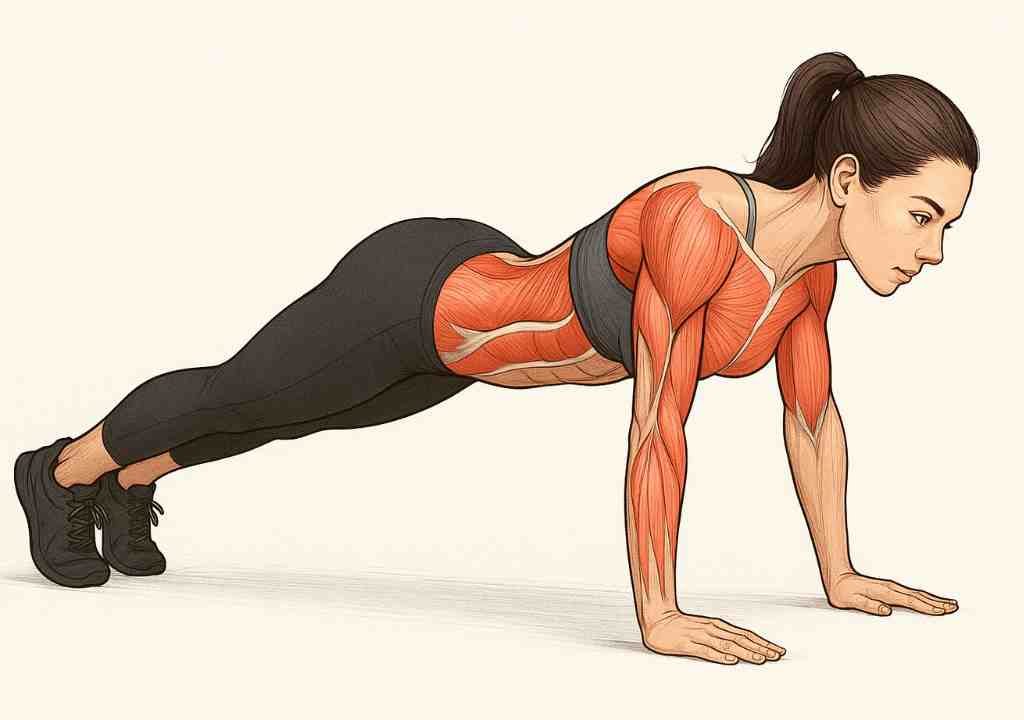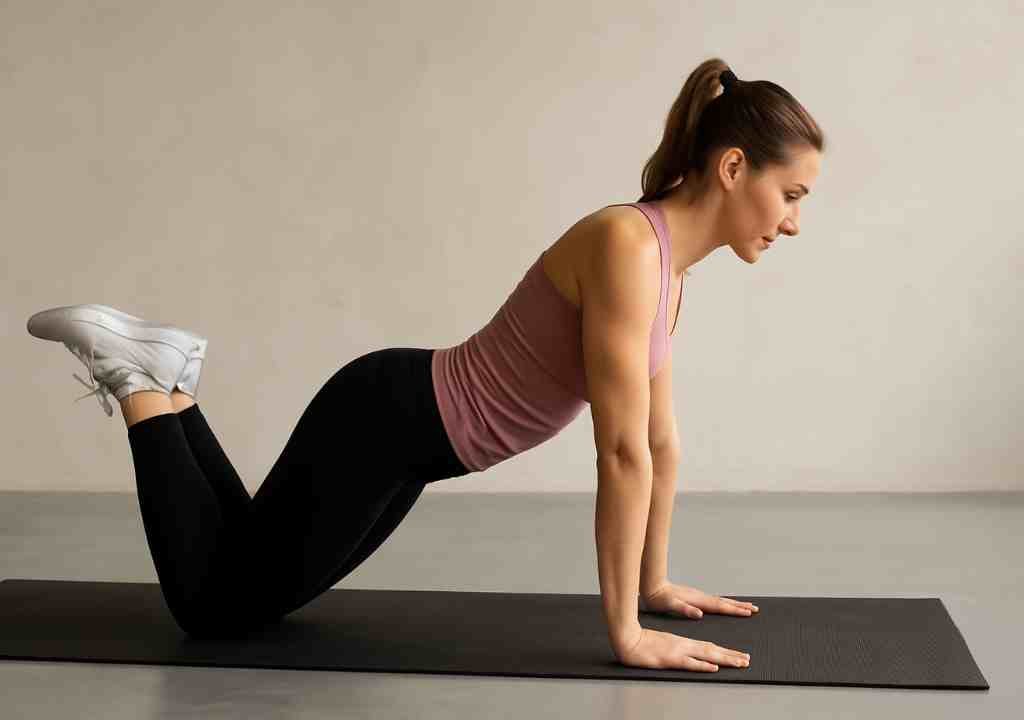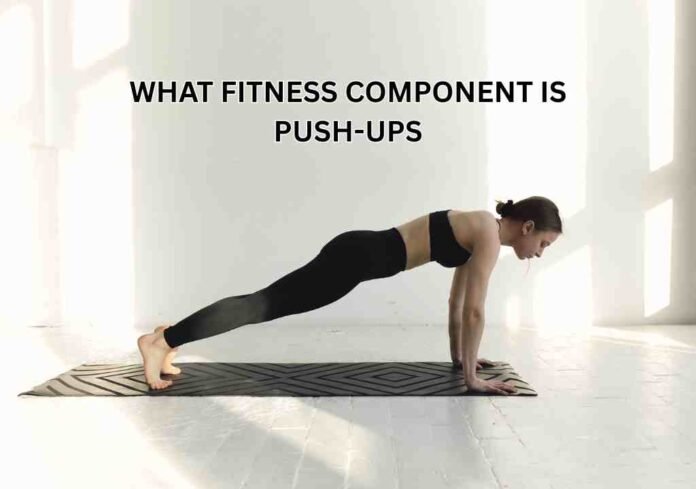Push-ups might seem like just another basic exercise — no equipment, no fancy moves — but don’t underestimate them. They’ve earned their spot in almost every workout routine for a reason. They’re right up there with squats and lunges when it comes to functional bodyweight exercises that build strength and stability.
Why Push-Ups Are More Than Just an Exercise
Table of Contents
Whether you’re new to fitness, a seasoned gym-goer, or training for something serious like a military test, push-ups are always part of the plan. And that’s not by accident — it’s because they work.
The Universal Appeal of Push-Ups
Push-ups are accessible, effective, and endlessly adaptable. They suit everyone — from absolute beginners to elite athletes. No matter your age or fitness level, there’s a push-up variation that meets you where you are.
Why Fitness Experts Still Recommend Them
Coaches, physiotherapists, and trainers continue to use push-ups to evaluate upper-body strength, endurance, core control, and injury resilience. They’re a staple in military fitness tests, school assessments, and rehabilitation programs because they reveal so much about how your body performs under pressure.
But here’s a question a lot of people ask: what fitness component is push-ups really testing? If that’s crossed your mind, you’re definitely not alone. And understanding the answer can actually help you get more out of your workouts.
In this article, we’re breaking it all down in plain, simple terms — we’ll look at what fitness component push-ups are designed to measure, why it matters, and how this one move can benefit different fitness levels and goals. Spoiler alert: it’s about a lot more than just building chest muscles.
To get the full picture, we’ll take a closer look at what’s happening inside your body during a push-up. Sure, they test your strength — but the real star of the show? Muscular endurance. And once you see how much this one move is doing, you’ll never look at push-ups the same way again.
🔁 What Fitness Component Are Push-Ups Really Testing?
Think back to your school gym class, a sports tryout, or even a military-style bootcamp. You probably remember the moment someone told you to “drop and give me 20.” And chances are, you’ve done push-ups as part of a fitness test or challenge at some point in your life.
But here’s the thing — those push-ups weren’t just about proving you could push your body weight off the floor. They were measuring something specific. So, what fitness component is push ups really testing? Simple answer: muscular endurance.
🧠 The Main Focus — Muscular Endurance
Muscular endurance is like your muscles’ version of long-distance stamina. It’s the ability to keep going — rep after rep — without your muscles giving out halfway through. You don’t need superhuman strength to have good endurance. What you need is the capacity to perform repeated movements without form breaking down and without quitting early.
Push-ups are an ideal way to test that. In fact, a controlled study on ResearchGate confirmed that push-up training over four weeks significantly improved muscular endurance — especially when using plyometric variations. They challenge your chest, triceps, shoulders, and core to work together, stay coordinated, and repeat the same movement again… and again… and again. Whether you can do 10 or 50, it’s not just about how strong you are — it’s about how long you can stay strong.
💡 Muscles Involved During a Push-Up

Push-ups may look simple on the outside — but inside your body, they’re anything but. What seems like a basic up-and-down motion is actually a team effort between several major muscle groups, all working in sync.
Here’s who’s involved:
- Chest (pectorals) – the driving force pushing you up from the floor
- Shoulders (deltoids) – helping stabilize the arms and movement path
- Triceps – powering that elbow extension as you press up
- Core stabilizers – including your abs and lower back, keeping your spine straight and your posture solid
And it’s not just about doing one perfect rep. Push-ups ask these muscles to stay coordinated and consistent, even as fatigue creeps in. When you hit your 15th, 30th, or even 50th push-up, it’s not strength that’s keeping you going — it’s pure, trained endurance.
🔬 The Sneaky Endurance Test Hiding in Plain Sight
The beauty of push-ups is how unassuming they are. No fancy machines, no gym needed — just you, your bodyweight, and gravity. But the further you go into a set, the more they reveal about your body’s capacity to handle pressure.
Your muscles burn. Your breathing gets heavier. Your mind says “stop,” but your body tries to squeeze out just one more. That’s why push-ups are a favorite in any push-up training program for endurance athletes — because they build the mental and muscular resilience that shows up in real-life movement.
🙌 Where Muscular Endurance Shows Up in Real Life
You don’t have to be an athlete to benefit from better endurance. Here’s where you’ll feel it in your everyday life:
- Holding better posture when you’re sitting or standing for hours
- Lifting and carrying without feeling like your arms are falling off
- Recovering faster between workouts or physical tasks
- Keeping good form longer, especially in long workouts or labor-intensive jobs
And let’s not forget one of the best parts — push-ups are free and accessible. No gym? No problem. They’re adaptable to almost any fitness level, and when paired with smart practices like push-up form tips to prevent injury, they can be one of the safest and most rewarding moves in your entire routine.
💪What Fitness Component Is Push Ups Also Testing? Let’s Talk About Strength
We’ve already covered how push-ups are a top-tier way to build muscular endurance. But that’s not the whole story. If you’ve ever struggled through a slow, deep rep or tried a push-up with your feet elevated — you’ve felt it: muscular strength stepping in.
While endurance is about how long your muscles can last, muscular strength is all about how much force they can produce in a single effort. It’s about power. Control. And the ability to push hard, even if it’s only for a few solid reps.
🏋️♂️ When Strength Becomes the Star
In your average fitness test — like doing as many push-ups as you can in a minute — endurance is clearly in the spotlight. But shift the format just a little, and now strength takes the lead.
Try one of these:
- Archer Push-Ups – You’re pushing almost all your weight with one arm. Think of it like a bodyweight bench press — for one side at a time.
- Clapping Push-Ups – These demand speed, explosiveness, and serious upper-body control. No slow grinding here — just burst, pop, and lift.
- Decline or Weighted Push-Ups – Put your feet up on a platform or strap on a weighted vest, and now each rep becomes a full-body challenge.
These versions don’t just test how long you can go — they ask how hard can you push in each moment. That’s the muscle strength component showing up in full force.
📈 How to Build Strength with a Push-Up Progression Plan
If building strength is your goal, doing endless reps won’t get you there. Instead, you need a more focused approach — a solid push-up progression plan for strength.
Here’s how it usually looks:
- Fewer reps per set (around 3–8), focusing on control and difficulty
- Slower movement, especially on the lowering phase, to increase muscle tension
- Elevated hand or foot positions to challenge range and mechanics
- Explosive push-ups, like plyo or pause reps, to build force output
This kind of plan shifts your body’s training from endurance mode into power mode. It teaches your muscles to generate more force with fewer movements, which is the very definition of strength. Over time, you’ll notice yourself not just doing more push-ups — but doing stronger, cleaner, and more powerful ones.
🔍 Strength vs. Endurance: What’s the Difference?
Still thinking about what fitness component is push ups truly targeting? The answer really depends on how you’re performing them.
Here’s a simple breakdown to keep in mind:
| Focus | Reps per Set | Intensity | Training Goal |
|---|---|---|---|
| Muscular Endurance | 12–25+ reps | Bodyweight, high volume | Sustain movement without fatigue |
| Muscular Strength | 3–8 reps | Weighted or advanced forms | Generate more force per repetition |
So, if you’re flying through 20+ reps? That’s endurance.
Taking it slow with a weighted vest or deep decline push-up? That’s strength work.
The real beauty of push-ups is that they’re incredibly adaptable. With just a few small changes, you can switch between building lasting stamina or raw power — all without leaving your living room.
🧍♀️What Push-Ups Really Do for You (Way Beyond the Gym)
Push-ups don’t need any equipment, and they don’t need much space — but they deserve a lot more credit than they usually get. Ask most people, and they’ll say push-ups are for building upper-body strength or getting through a workout challenge. But if you take a closer look, they actually support the kind of strength you use every single day.
In fact, when done right, push-ups do far more than help you “get fit.” They help you move better. Stay balanced. Protect your joints. And build the kind of control your body needs when life throws you off balance — literally.
Let’s walk through the surprising, real-life benefits push-ups offer outside the gym walls.
⚖️ 1. Steadier Balance and a Core That Works Overtime
You might think push-ups are just an arm-and-chest kind of thing. But that’s only part of the story.
The moment you start lowering your body to the floor, your core is already hard at work — stabilizing, controlling, and holding you in alignment. Your abs, lower back, and even your hips are helping to keep you from wobbling or collapsing.
Want to train balance more intentionally? That’s where push-up techniques for balance enhancement come in. Try:
- Single-leg push-ups to challenge stability
- Shoulder tap push-ups to train anti-rotation
- Push-ups on an unstable surface (like a balance pad or BOSU ball) to wake up your entire midsection
These tweaks don’t just make the movement harder — they teach your body to stay composed under pressure. And you’ll start noticing the payoff everywhere:
- Walking more confidently on uneven ground
- Catching yourself before a stumble turns into a fall
- Standing or sitting taller, without even thinking about it
🛡️ 2. Joint Protection You Didn’t Know You Needed
One of the best “side effects” of push-ups? They help protect the parts of your body that most people forget to train — like your wrists, shoulders, and elbows.
By working the smaller stabilizer muscles around those joints, push-ups act like a built-in defense system. But technique matters. That’s why it’s worth learning and practicing push-up form tips to prevent injury, such as:
- Keeping your neck in line (no craning up or tucking under)
- Lining up your wrists directly under your shoulders
- Engaging your glutes and abs so your hips don’t sag
Stick with good form, and over time, you’ll likely experience fewer of the usual aches — things like:
- Shoulder pinching when reaching overhead
- Wrist fatigue during computer work
- That low-back strain that sneaks in during long days on your feet
And it’s not just about avoiding injuries. It’s about feeling more stable and supported in movements you do every single day.
🧘 3. Push-Ups That Heal, Not Hurt
If you’re dealing with limited mobility or coming back from an injury, push-ups might feel out of reach. But that’s where the push-up exercises for rehabilitation come in.
These aren’t your standard reps-to-failure sets. They’re gentle, smart, and designed to help your body relearn strength gradually. Some of the go-to variations include:
- Wall push-ups – done standing, with minimal pressure on the joints
- Incline push-ups – using a table, bench, or even stairs
- Partial range push-ups – building confidence and control one inch at a time
These options let you move at your pace, strengthen at your level, and get stronger without setting yourself back. Over time, your joints get more flexible, your coordination comes back online, and your body starts to trust movement again — a big win for anyone recovering or restarting.
🔁 Functional Strength That Pays Off in the Real World
Let’s be honest — most of us aren’t training to win fitness trophies. We’re training so we can keep up with life.
Push-ups mimic everyday actions more than you might realize:
- Pushing open a heavy door
- Getting off the floor without strain
- Lifting your child or hoisting a bag into the car
- Bracing yourself when you slip or trip
Every one of those real-world moves involves the same muscles you use in a push-up — chest, shoulders, triceps, core. The more reps you build in good form, the more reliable those muscles become when you need them most.
So the next time you drop to the floor for a set, know this: you’re not just building muscle. You’re building stability, confidence, and movement skills that show up in the moments that matter most.
🧍♂️Push-Ups for Every Body: From Grandma to Bootcamp
When you think of push-ups, your mind might go straight to military drills, intense bootcamps, or that one gym class memory you’d rather forget. But here’s the thing — push-ups aren’t just for the young, tough, or super-fit. They’re one of the most adaptable, practical exercises out there. Whether you’re 70 and working on balance, or 25 and prepping for a fitness test, there’s a version of the push-up made for you.
Let’s look at two ends of the spectrum — and see how this one simple move fits into both.
👵 Push-Ups for Seniors: Gentle Strength for Everyday Life
Aging doesn’t mean weakness — but it does mean we have to move smarter. For older adults, even small things like reaching for a shelf, pushing off the couch, or catching yourself during a trip can start to feel more difficult. That’s where push-up workouts for seniors come in. The goal isn’t to break records — it’s to build steady, dependable strength that shows up when life demands it.
💡 Easy Push-Up Modifications That Truly Work:
- Wall Push-Ups – Standing tall and leaning into a wall. It’s a great entry point and gentle on the joints.
- Incline Push-Ups – Using something like a kitchen counter or bench to ease the resistance while still engaging the muscles.
- Knee Push-Ups – A softer version that takes pressure off the shoulders and wrists but still targets the core and arms.
These smart push-up modifications for seniors help with:
- Upper body strength to lift, carry, and support yourself
- Core stability to stay upright and balanced
- Confidence to move through your day without hesitation
- Joint mobility that keeps you fluid and flexible
✅ And maybe the best part? You don’t need a gym. No special gear. Just a few feet of space and your own body. Push-ups give seniors an empowering way to stay active, safe, and self-reliant — right at home.
🪖 Push-Ups for the Tough Stuff: Military Recruits & Endurance Athletes
Now, let’s flip the script. In the military, push-ups are more than a warm-up — they’re a benchmark. Recruits are expected to drop down and perform under pressure, fatigue, and time limits. It’s why push-up programs for military fitness tests are intense and strategic. These aren’t just workouts — they’re readiness rituals.
Push-ups in these settings are used to test:
- Muscular endurance — how long can your upper body last?
- Breathing and pacing under stress
- Mental toughness — that “one more rep” mindset
- Form consistency, even when you’re gassed
And for endurance athletes — think marathoners, cyclists, rowers — the upper body often gets overlooked. But it plays a vital role in posture, breathing mechanics, and total-body control. That’s why a solid push-up training program for endurance athletes is key to rounding out their performance.
Here’s what those programs usually include:
- Timed push-up sets to mimic fitness test pacing
- Supersets that pair push-ups with cardio bursts (like jump rope)
- Slow push-ups for maximum muscle engagement and control
- Tempo-based reps to hit different muscle fibers and build sustainable power
🎯 The result? A stronger, more resilient upper body that won’t cave under fatigue — in a race, on the battlefield, or anywhere life demands grit.
🏁 Same Move, Different Goals — And That’s the Magic
It’s kind of incredible, isn’t it? The same push-up that helps a grandparent stay steady on their feet is also the one helping a young recruit crush a fitness test. That’s what makes it such a powerful movement — it adapts to you.
You don’t have to do 50 reps. You don’t need to be perfect. You just need to start where you are.
So whether you’re easing into fitness after 60, or training to meet a physical standard that pushes your limits — push-ups have a place in your journey.
It’s not about being the strongest.
It’s about becoming stronger than you were yesterday.
🔄 Best Push-Up Variations for Beginners (Build Strength Without Burning Out)
Let’s keep it real — push-ups aren’t easy at first. You drop to the floor, your arms start to wobble, your form feels all over the place, and you wonder, “Am I even doing this right?” You’re not alone — we’ve all been there. And guess what? Struggling doesn’t mean failing. It means you’re starting — and that takes guts.
That’s why it’s so important to begin with push-up variations designed for beginners. These aren’t watered-down versions — they’re smart stepping stones. They help you ease into proper form, avoid injury, and build the kind of strength that sticks with you.
So, if you’re ready to ditch the frustration and start building real progress, here are the best push-up variations for beginners — simple, safe, and totally doable — and when paired with belly fat–targeted exercises like the 7-minute workout, you’ll start seeing results across your midsection too.
🧱 1. Wall Push-Ups
For: absolute beginners, sore wrists, or post-injury recovery
This is the friendliest push-up on the block. Stand facing a wall, place your hands flat at shoulder height, and slowly lean in like you’re giving it a gentle chest bump. Then press back. That’s it.
✅ Why wall push-ups work:
- Super low-impact, so your joints stay happy
- Teaches you the feel of a push-up without the pressure
- Great for balance, posture, and core awareness
It may seem easy, but it quietly activates your chest, shoulders, arms, and even your abs. Plus, it gives you a great foundation before moving to the floor.
🪑 2. Incline Push-Ups

For: easing into more resistance without the overwhelm
Ready to graduate from the wall? Grab a kitchen counter, sturdy table, or park bench. The higher the surface, the easier it is — so you can tailor the challenge to your current strength level.
✅ Why incline push-ups are perfect:
- Light on the wrists and lower back
- Reinforces proper push-up alignment
- Scales up easily as you get stronger
This is the sweet spot between “too easy” and “too hard.” It teaches your body to move well — without dragging you into injury territory.
🧎♀️ 3. Knee Push-Ups

For: building real push-up strength with a bit of support
Knees down, back straight, core tight — and you’re good to go. Knee push-ups help you work through the full push-up range, just with less bodyweight load.
💡 Pro tip: Use push-up form tips to prevent injury. Keep your elbows angled about 45 degrees, brace your core, and don’t let your hips sag.
✅ Why it matters:
- Builds upper-body endurance without burnout
- Keeps your form cleaner and safer
- Makes it easier to transition to full push-ups later
Think of it as “training wheels with muscle.” You’re still getting a serious workout — just with a little more support.
🐢 4. Slow Eccentric Push-Ups

For: mastering control, stability, and body awareness
This one is a game-changer. Slowly lower yourself for 3 to 5 seconds — then either push back up (if you can) or gently reset. That slow descent builds real strength and teaches your body exactly how a good push-up feels.
✅ Why you’ll love it:
- Builds muscle control, not just strength
- Sharpens your form and body alignment
- Helps train both your mind and muscles for progress
This technique might feel humbling at first — but trust us, it’s powerful. You’re building the foundation for all kinds of push-up variations in the future.
💬 Why These Variations Matter
Here’s the truth: trying to jump straight into full push-ups can feel discouraging. And worse, it can lead to poor form or even injury. But that doesn’t mean you’re not capable — it just means your body deserves to build up smartly.
These beginner variations do more than just prep your muscles. They help you:
- ✅ Learn proper technique that protects your joints
- ✅ Strengthen stabilizing muscles that improve posture and control
- ✅ Build muscular endurance in a safe, gradual way
- ✅ Feel good about your progress, not frustrated by it
And you don’t need anything fancy. No gym, no trainer, not even a yoga mat. Just your body, a wall, a little time — and a decision to keep showing up.
Because progress isn’t measured in perfect reps. It’s measured in consistency, self-kindness, and the quiet strength you build with every try.
🔁 How to Track the Component Over Time (And Actually See Your Progress)
Let’s be real — doing push-ups day after day without knowing if you’re improving can feel frustrating. But here’s the good news: muscular endurance is measurable, and tracking it doesn’t require fancy apps or gym equipment. You just need a simple plan, a stopwatch (your phone works just fine), and a little consistency.
By regularly tracking a few key benchmarks, you’ll not only see your progress — you’ll feel more motivated to keep going. Here’s how to do it:
✅ 1. Max Push-Ups in 60 Seconds
What it tracks: Pure muscular endurance and cardiovascular stamina.
Set a timer for 60 seconds and perform as many push-ups as you can with good form. Don’t rush through sloppy reps — focus on quality.
📝 What to record:
- Total number of reps
- How consistent your pace is (e.g., do you start strong and fade, or keep steady?)
- Whether your form holds up by the end
💡 Track this once a week, same time and conditions. Over time, you’ll notice your rep count going up and your form staying tighter — both great signs of improved endurance.
✅ 2. Total Push-Ups Across 3 Sets
What it tracks: Muscular recovery and stamina over short rest periods.
Do three sets of push-ups, resting 60 seconds between each one. Write down how many solid reps you complete in each round.
📝 What to record:
- Reps in Set 1, Set 2, and Set 3
- How much your performance drops from set to set
- Any changes in how hard the sets feel week to week
💡 The goal is to close the gap between your first and last set — which means your muscles are recovering faster and handling more volume. It’s also a great way to simulate real-life endurance where strength needs to last over time, not just in one burst.
✅ 3. Quality of Form Across Reps
What it tracks: Muscular control, joint stability, and movement consistency.
Endurance isn’t just about doing more — it’s about doing better. Pay attention to how your body feels and moves through each rep.
👀 Things to watch for:
- Are your hips sagging as you fatigue?
- Is your head dropping, or your elbows flaring too wide?
- Can you maintain a controlled pace from start to finish?
💡 Take a video of yourself once in a while (you don’t have to post it — it’s just for you!). This helps you catch form breakdowns you might not feel while working out. Maintaining good technique as your reps increase is a huge sign of true endurance progress.
🧠 Bonus Tip: Keep a Simple Log
Use a notes app or journal to track weekly gains — and if your goal is fat loss or a more defined upper body, you might also want to track weight loss in a structured 2-week plan or focus on losing upper back fat as part of your visual progress markers. Log your results weekly with notes like:
“Week 3: 23 push-ups in 60 sec, felt easier. Set 3 didn’t drop as much. Core held strong.”
This gives you real, tangible proof of improvement — something to look back on when motivation dips or you hit a plateau.
💬 Why It Matters
Tracking doesn’t just keep you accountable — it turns your workouts into a journey. You’ll move from “I can barely do 10” to “Wow, I just did 25 with perfect form.” And that shift? It’s more than numbers — it’s confidence, strength, and visible growth you can be proud of.
💡 What Fitness Component Do Push-Ups Really Measure?
Push-ups might seem simple — just you and the floor. No machines, no weights. But don’t be fooled. They quietly train way more than you’d expect.
So, what fitness component is push-ups really measuring?
Muscular endurance — especially in your chest, shoulders, arms, and core.
But that’s not all they do. Let’s keep it real:
🏋️ Muscular Endurance — Your Staying Power
This is the main deal. Push-ups show how long your upper-body muscles can keep going without tapping out. If your reps stay strong even when you’re tired, your endurance is on point. It’s that simple.
You’ll feel it most in:
- Chest
- Shoulders
- Triceps
- Core
Whether you’re knocking out 60 seconds of push-ups or just trying to get through 3 solid sets — muscular endurance is what’s being tested and built.
💪 Muscular Strength — The Quiet Bonus
Push-ups aren’t just about going long — they’re also about going strong. Especially when you slow them down or level up the difficulty.
Want to build strength too? Try:
- Slow eccentric push-ups
- Decline push-ups
- Weighted reps
These moves feed into a push-up progression plan for strength — helping you push harder and control your body better over time.
⚖️ Core Stability & Balance — The Hidden Power
Here’s a secret: great push-ups don’t come from your arms alone. Your core — abs, back, obliques — is what keeps you steady and aligned.
Variations like:
- Single-leg push-ups
- Shoulder tap push-ups
…are all push-up techniques for balance enhancement. They don’t just build muscle — they improve control and help prevent injury.
🔁 Functional Strength — For Real Life Stuff
Push-ups train movement you actually use:
- Pushing open a door
- Getting up from the floor
- Lifting a kid or bag
- Catching yourself from a fall
They’re not just workouts. They’re practice for everyday strength — the kind that makes life easier and safer.
🎯 Why Push-Ups Just Work
Push-ups are:
- Easy to start
- Easy to adjust
- Done anywhere, no gear needed
Whether you’re a total beginner or training for a push-up program for military fitness tests, they’ll meet you where you are.
And that’s the magic:
Push-ups build endurance, strength, balance, and function — all in one move.
No gym. No excuses. Just results — and if you’re pairing push-ups with the right healthy post-workout snacks, that progress shows up faster and feels better.
✅ Final Thoughts: Make Push-Ups Work for You
From push-up exercises for rehabilitation to push-up programs for military fitness tests, this move can be tailored to suit almost any fitness level or goal.
So next time you drop down for a set, remember — you’re not just doing a basic exercise. You’re improving a foundational fitness component that supports strength, stamina, and lifelong functionality.
FAQ: Push-Ups & What They Really Do for You
1. What fitness component do push-ups mainly improve?
Push-ups are all about muscular endurance — think of it as your muscles’ ability to keep going, rep after rep, without giving out. When you’re doing push-ups, it’s not just strength you’re building — it’s how long your chest, shoulders, arms, and core can keep working without burning out.
2. Can push-ups build strength too, or just endurance?
Yes — 100%. While traditional push-ups lean toward endurance, you can turn them into strength builders with a few smart tweaks. Add a weighted vest, elevate your feet, or slow down your reps — suddenly, you’re asking your muscles to push harder and grow stronger.
3. Are push-ups safe for older adults or people coming back from injury?
They can be — as long as you keep it gentle and smart. Wall push-ups, incline push-ups, and shorter ranges of motion are fantastic ways to ease in. They give your body the chance to rebuild strength, improve joint stability, and move confidently — all without risking strain.
4. What muscles do push-ups really work?
It’s not just your chest. Push-ups train a whole team of muscles — including your shoulders, triceps, abs, and lower back. Do them with good form, and you’re also building balance, posture, and body control with every rep.
5. How can I tell if I’m actually improving at push-ups?
You don’t need fancy tech — just your phone and a little consistency. Try this:
Count how many solid push-ups you can do in 60 seconds
Do 3 sets with short rest and watch how your stamina holds up
Occasionally film yourself to check form and posture
Write it down week by week — those little changes in strength, form, and rep count? That’s your real progress showing up.























